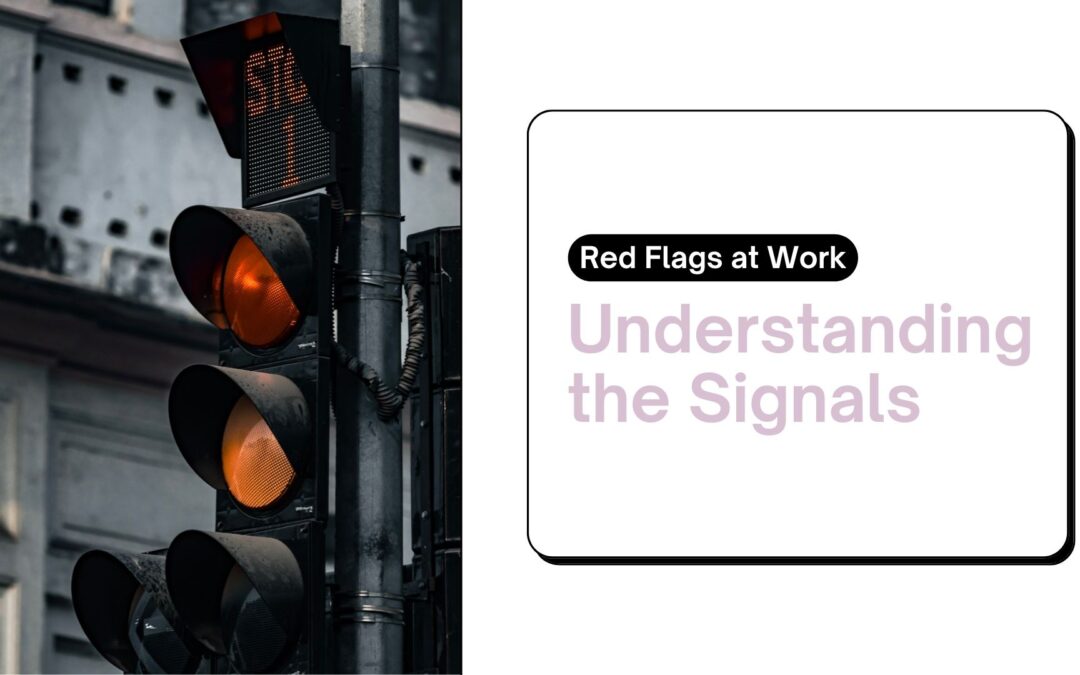Throughout our careers, we encounter various signs that can either guide us forward or signal a need to reassess. These signs—whether red, amber, or green flags—are present in everyday professional situations, and understanding how to spot them can be the difference between thriving or struggling at work.
But there’s more to it than just recognising these flags. Our intuition, often referred to as the “gut feeling,” plays a significant role in helping us navigate these situations. Recent research highlights the powerful connection between our brain and our gut, often referred to as the “second brain.” This connection is vital when it comes to decision-making, particularly when spotting flags early on.
Understanding the Flags in Your Career
Just like traffic signals, flags in your professional life tell you when to proceed, when to slow down, and when to stop. Here’s a breakdown:
Red Flags: Stop, Something’s Wrong
Red flags are clear signals that something is not right, and they need your immediate attention.
Ignoring red flags in your professional life can lead to long-term damage, such as burnout, dissatisfaction, or unhealthy work relationships. Trusting your gut is key here—if something feels wrong, it probably is. Acknowledge the red flag, and don’t be afraid to make changes. This might mean addressing issues with a manager, setting boundaries, or even considering a new job. If you’ve overlooked the warning signs and things have escalated, act quickly. Have the difficult conversation, seek support, or pivot in a way that aligns with your well-being and professional growth.
Amber Flags: Proceed with Caution
Amber flags are subtle and often easier to dismiss. They signal potential issues that could escalate if left unchecked.
Amber flags require a closer look and often, an open conversation. It’s tempting to shrug these off as temporary issues, but your gut feeling is usually alerting you to a larger pattern. Take the time to reflect on what’s bothering you and address it before it becomes a bigger problem. Amber flags give you the opportunity to course-correct early on, so lean into your intuition and don’t let those small nagging feelings go unnoticed.
Green Flags: Go, You’re on the Right Path
Green flags are positive signs that you’re in a healthy professional environment.
Celebrate these moments. Green flags are signs that you’re in a good place professionally. Continue nurturing these relationships, stay curious, and keep fostering the practices that contribute to your success and satisfaction.
Trusting Your Gut – The Science Behind Intuition
It’s easy to ignore subtle warnings when everything seems fine on the surface. But have you ever had a feeling in your gut that something wasn’t quite right, even when you couldn’t explain it? That’s your intuition at work, and it’s more scientifically grounded than you might think.
Your gut is often referred to as your “second brain” due to its connection with the central nervous system. Researchers have found that the gut has its own neural network, called the enteric nervous system, which communicates with the brain via the vagus nerve. This gut-brain axis plays a crucial role in how we experience emotions, make decisions, and respond to stress.
Neuroscientist Antonio Damasio’s research emphasizes that our emotions, including those gut feelings, are deeply linked to our decision-making process. Our brain uses stored memories and past experiences to help us process new situations rapidly, which is why trusting your gut is often the fastest way to sense a red or amber flag.
My Own Experience: Ignoring the Red Flag
I recently had a personal experience where I sensed red flags early on in a situation. At the time, I wanted to give it the benefit of the doubt, trusting that perhaps things would work themselves out. However, my intuition was telling me something was wrong. Unfortunately, as time went on, the red flag turned out to be valid, and I had to backtrack and recover from the fallout. It was a lesson in trusting my gut from the start. Had I acted on that initial discomfort, I could have avoided some of the challenges that followed. It’s easy to ignore these signs when you’re hoping for the best, but they’re there for a reason.
Course-Correcting When You’ve Ignored the Red Flag
We’ve all been there — a red flag goes unnoticed, or worse, we acknowledge it but hope it’ll resolve itself. But when things take a turn for the worse, here’s how you can course-correct:
- Acknowledge the Situation: Don’t let denial delay your response. Admitting that there’s a problem is the first step.
- Take Ownership: Whether it’s a project, a relationship, or even your own well-being, owning the fact that a red flag was missed empowers you to make changes.
- Act Quickly: Time is of the essence when dealing with red flags. Whether it’s setting boundaries or seeking advice, the sooner you act, the more manageable the issue becomes.
- Learn for the Future: Reflect on why the red flag was missed. Was it fear of change, a desire to avoid conflict, or something else? Understanding this can help you trust your gut more readily next time.
Trust the Signals and Your Intuition
Red, amber, and green flags are constantly present in our professional lives, and learning to spot them can help us make better decisions. But just as important is trusting the intuition that alerts us to those signals in the first place. Your gut is more than just a feeling — it’s a tool for navigating your career with clarity and confidence. So, the next time a situation doesn’t sit right with you, don’t ignore that inner voice. Listen, evaluate, and act.

